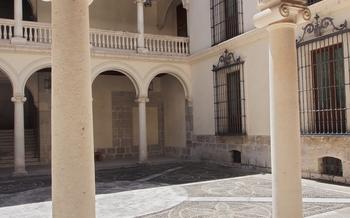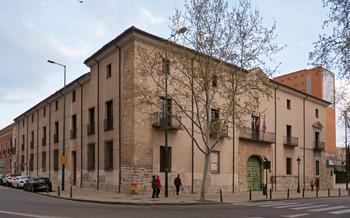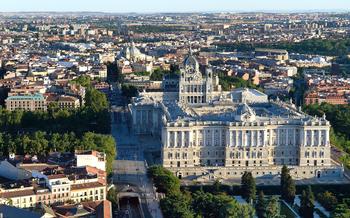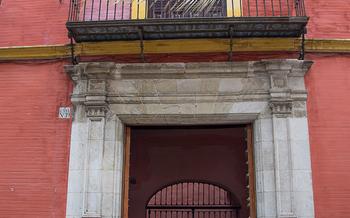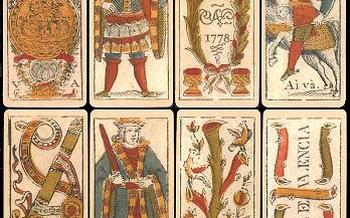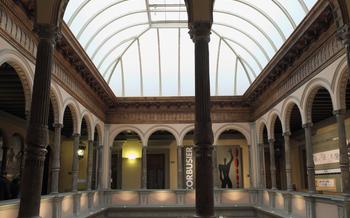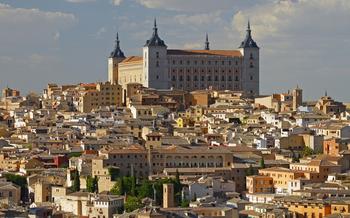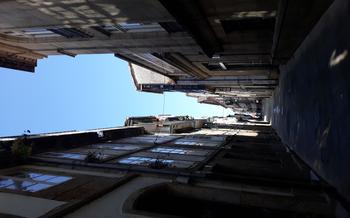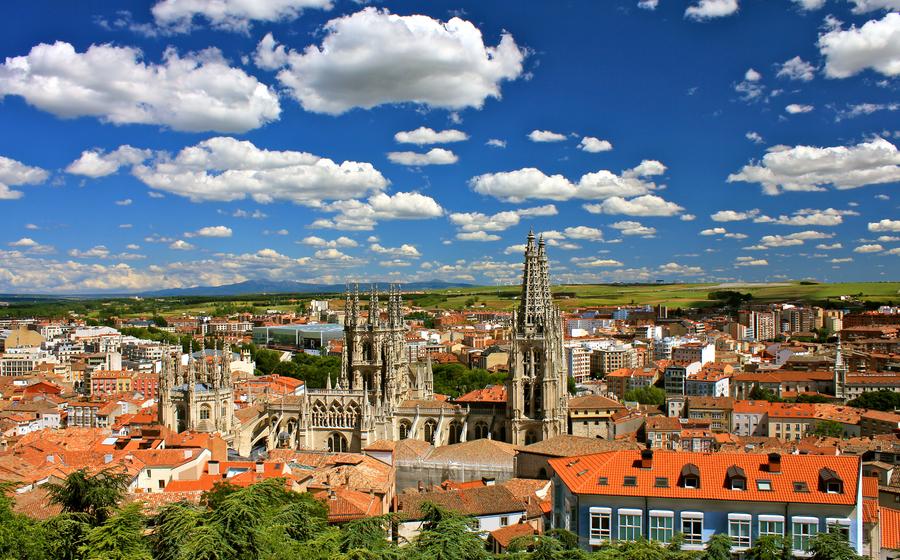
Palacio de los Saldaña
- Palacio de los Saldaña: An Architectural Masterpiece
- The Saldaña Family Legacy
- The Hall of Mirrors
- The Throne Room
- The Dining Room
- The Music Room
- The Ballroom
- Tips for Visitors
Palacio de los Saldaña: An Architectural Masterpiece
The Palacio de Burgos. Built in the 16th century, the palace boasts a unique blend of Renaissance and Gothic styles, showcasing the transition between these two significant periods. Its intricate facade, adorned with elaborate carvings and decorative elements, hints at the grandeur that awaits within.
Located in the heart of Burgos' historic center, the palace is easily accessible on foot or by public transportation. Its strategic position allowed the Saldaña family, one of the most influential families in the region, to maintain close ties with the city's political and social circles.
The Saldaña Family Legacy
The Palacio de los Saldaña is not just an architectural masterpiece; it is also a testament to the legacy of the illustrious Saldaña family, who played a pivotal role in shaping the history and development of Burgos. The Saldañas, a noble and influential lineage, rose to prominence in the 14th century, leaving an indelible mark on the city's social, political, and cultural fabric.
The Saldaña family's origins can be traced back to the medieval Kingdom of Castile, where they held positions of power and prestige. Over the centuries, they amassed vast wealth and influence, becoming one of the most prominent families in the region. Their involvement in politics, trade, and philanthropy left a lasting impact on Burgos, contributing to its growth and prosperity.
The Saldaña family's commitment to their hometown is evident in their numerous contributions to the city's development. They were patrons of the arts and culture, supporting local artists and sponsoring religious institutions. Their philanthropic endeavors extended to the establishment of hospitals, schools, and other charitable organizations, demonstrating their deep-rooted sense of social responsibility.
The Saldaña family's influence is reflected in the city's urban landscape, with several notable landmarks bearing their name. The Palacio de los Saldaña, a testament to their architectural legacy, stands as a symbol of their power and prestige. Their coat of arms, featuring a rampant lion and a castle, can be seen throughout the city, adorning buildings, fountains, and public spaces, serving as a reminder of their enduring presence in Burgos.
The Saldaña family's legacy is one of power, influence, and philanthropy. Their contributions to Burgos's social, political, and cultural development are still visible today, making them an integral part of the city's rich history and identity.
The Hall of Mirrors
The Hall of Mirrors at the Palacio de los Saldaña is a testament to the family's exquisite taste and lavish lifestyle. This grand chamber, adorned with intricate mirrors and opulent furnishings, was designed to impress and entertain guests.
The walls of the hall are lined with floor-to-ceiling mirrors, creating an illusion of infinite space and reflecting the room's splendor from every angle. The mirrors are framed in gilded wood, adding a touch of opulence to the already extravagant decor.
The ceiling of the hall is a masterpiece of artistry, featuring intricate frescoes depicting scenes from mythology and history. The vibrant colors and lifelike figures seem to come alive, transporting visitors to another era.
The floor of the hall is covered in a rich, patterned carpet, adding to the luxurious ambiance. The carpet is adorned with the Saldaña family crest, a symbol of their power and influence.
The Hall of Mirrors has witnessed countless historical events and celebrations over the centuries. From lavish balls and banquets to intimate gatherings and private concerts, this room has played a pivotal role in the social and cultural life of Burgos.
Today, the Hall of Mirrors stands as a reminder of the Saldaña family's legacy and their contribution to the city's rich heritage. Visitors to the palace can step back in time and experience the grandeur and opulence of a bygone era.
The Throne Room
The throne room, a testament to the Saldaña family's authority and prestige, exudes an aura of power and grandeur. Its walls adorned with intricate carvings, each stroke narrating the family's rich history. The ceiling, a masterpiece of artistry, displays the Saldaña coat of arms, a symbol of their noble lineage.
The throne, a majestic seat of power, occupies the room's center, inviting visitors to imagine the regal figures who once sat upon it, making decisions that shaped the course of history. The intricate carvings that adorn the throne speak of the family's commitment to craftsmanship and their attention to detail.
Heraldry, a language of symbols, plays a prominent role in the throne room's décor. The walls are adorned with the Saldaña family crest, a visual representation of their lineage and achievements. Each symbol, each color, holds a deeper meaning, narrating the family's story through a visual language.
Historical ceremonies, imbued with pomp and circumstance, once took place within these walls. The enthronement of new family leaders, the signing of important treaties, and the celebration of significant milestones were all witnessed by these grand surroundings. The throne room stands as a silent witness to the passage of time and the unfolding of history.
The Dining Room
The dining room of the Palacio de los Saldaña is a testament to the family's lavish lifestyle and their love for entertaining. The room is adorned with intricate carvings, opulent chandeliers, and elegant furnishings, creating an atmosphere of grandeur and opulence.
In the past, the dining room played host to lavish feasts and banquets, where the Saldaña family and their guests would indulge in culinary delights and engage in lively conversation. The room's elaborate table settings, featuring fine china, crystal glassware, and silverware, reflected the family's refined taste and attention to detail.
Throughout history, the dining room has witnessed countless social gatherings, from intimate family dinners to grand receptions. It is said that the Saldaña family took great pride in their culinary traditions and often showcased their favorite dishes to their guests. The room's acoustics and elegant ambiance made it an ideal setting for lively conversations and laughter, creating lasting memories for all who dined within its walls.
The Music Room
The Palacio de los Saldaña's music room is a testament to the family's love for the arts. This elegant chamber boasts exceptional acoustic qualities, making it the perfect venue for intimate concerts and recitals. Throughout history, the room has hosted renowned musicians and composers, who have graced its stage with their enchanting melodies.
The music room's walls are adorned with intricate carvings and paintings depicting scenes of musical inspiration. The ceiling features a stunning fresco that portrays a gathering of angels playing various instruments, creating a celestial ambiance that enhances the musical experience.
In the center of the room stands a magnificent grand piano, an instrument that has witnessed countless performances and collaborations. The soft glow of candlelight illuminates the polished wood and ivory keys, adding a touch of warmth and intimacy to the space.
The Saldaña family often hosted musical gatherings in this room, where they would entertain guests with their own musical talents or invite professional musicians to perform. These events were not only a display of their appreciation for music but also a way to bring people together and foster a sense of community.
Today, the music room continues to be utilized for concerts, recitals, and other musical events. Visitors can attend these performances to experience the acoustics and ambiance that have inspired musicians for centuries.
The Ballroom
The ballroom of the Palacio de los Salda. It is a spacious and elegant hall, adorned with intricate carvings, gleaming chandeliers, and rich tapestries. The high ceiling creates a sense of grandeur, while the large windows allow natural light to flood the room, casting a warm glow on the polished marble floors.
In its heyday, the ballroom was the scene of lavish balls and celebrations. The Saldaña family hosted lavish events that attracted the cream of Burgos society. The room would be filled with the sound of music, laughter, and the clinking of glasses as guests danced the night away.
Today, the ballroom is still used for special events, such as weddings, conferences, and galas. It is a popular venue for those seeking a truly unique and memorable setting for their celebrations. The ballroom's grandeur and elegance transport guests back in time, allowing them to experience the opulence and glamour of the Saldaña family's lavish lifestyle.
One of the most striking features of the ballroom is its ornate chandeliers. These magnificent fixtures are made of crystal and bronze, and they hang from the ceiling like sparkling stars. The chandeliers reflect the light from the windows, creating a dazzling display that illuminates the entire room.
Another notable feature of the ballroom is its large windows. These windows offer stunning views of the city of Burgos. During the day, guests can enjoy the vibrant cityscape, while at night, they can admire the twinkling lights of the city below. The windows also allow natural light to flood the room, creating a bright and airy atmosphere.
Tips for Visitors
When planning your visit to the Palacio de los Saldaña, keep in mind the following tips to enhance your experience:
Best time to visit: The palace is open to the public from Tuesday to Sunday, with guided tours available at specific times. To avoid crowds, consider visiting during the week or early in the morning.
Dress code and etiquette: While there is no strict dress code, it is recommended to dress respectfully, as the palace is a historical and cultural landmark. Avoid wearing shorts, tank tops, or beachwear.
Photography guidelines: Photography is allowed inside the palace, but flash photography is prohibited to protect the artwork and historical artifacts.
Accessibility and facilities: The palace is wheelchair accessible, and there are restrooms and a gift shop on the premises. For those with limited mobility, guided tours with special accommodations can be arranged upon request.
